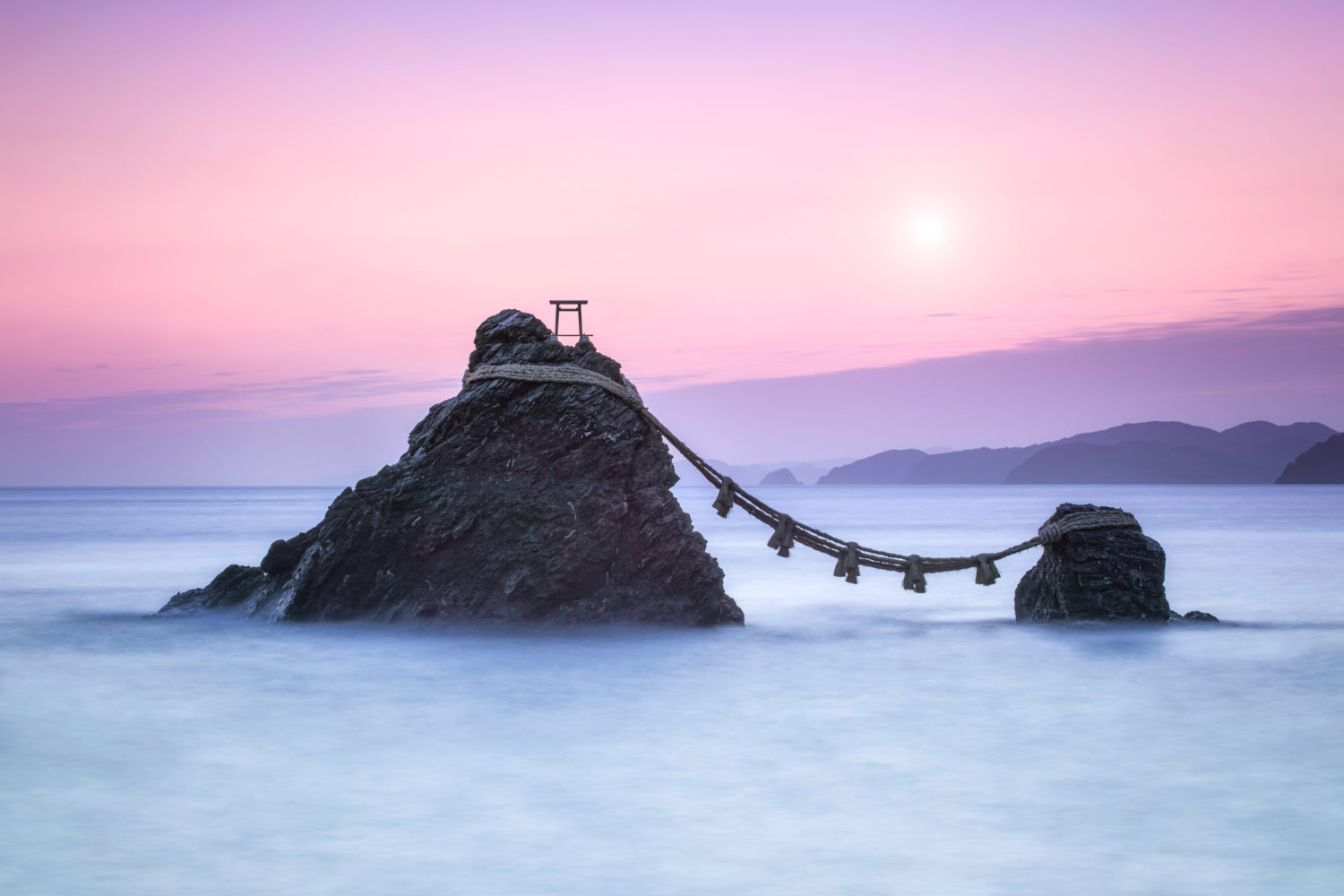
Situated in the Kansai region of Honshu, Mie offers a fascinating mix of Japan’s sacred history and natural beauty. This coastal region is home to Ise Jingu, Japan’s most revered Shinto shrine dedicated to the sun goddess Amaterasu, attracting pilgrims and tourists alike throughout the year.
You can also find the Sacred Meoto Iwa Rocks in Mie. Affectionately coined as the “Wedded Rocks”, they are connected by a sacred shimenawa rope, they symbolise the union of the Shinto deities Izanagi and Izanami, representing marriage and harmony. The most magical time to view them is at sunrise, especially during the summer when the sun rises perfectly between the rocks.
Mie’s diversity is remarkable, from the ancient pilgrimage routes of Kumano Kodo (a UNESCO World Heritage site) to the thrilling attractions of Nagashima Spa Land. Immerse yourself in ninja heritage at the birthplace of these legendary warriors, explore 1000-year-old forests, and witness traditional crafts being created by skilled artisans.
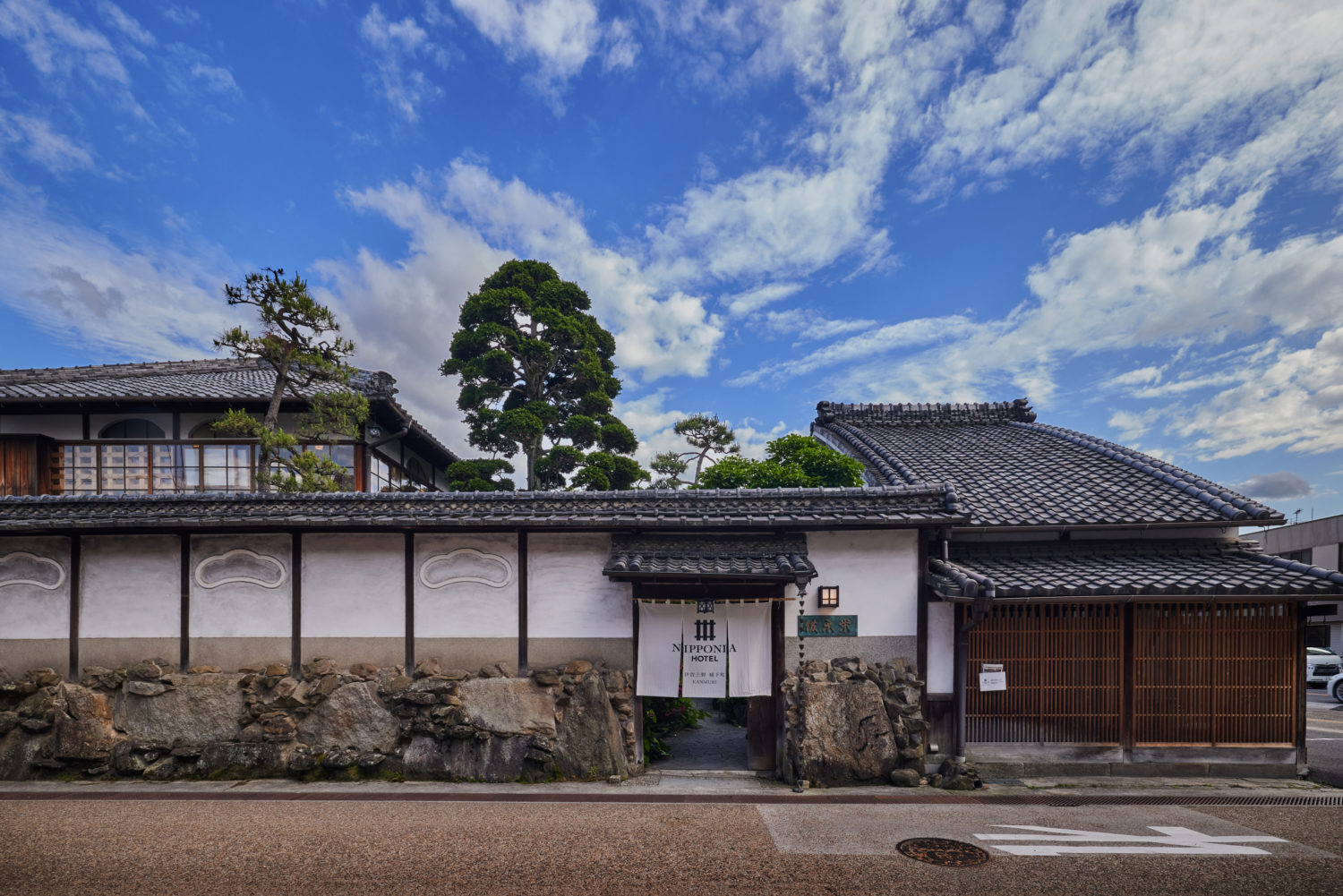
Iga – The Ninja Heartland
NIPPONIA HOTEL Iga Ueno
NIPPONIA HOTEL Iga Ueno offers a distinctive ‘dispersed hotel’ concept just five minutes from Iga Ueno Station. This distinctive accommodation spreads across multiple historical buildings in the castle town, allowing you to immerse yourself in local heritage. The hotel preserves a beautiful 150-year-old main house alongside several renovated traditional buildings, each maintaining traditional character whilst providing modern comforts.
You are transported between buildings via a convenient house car service, making exploration of this original ninja village effortless. The dining experience is exceptional, with French-inspired cuisine created from premium local ingredients including renowned Iga beef and rice.
Iga’s ninja heritage is subtly incorporated throughout, from clever food presentations to cultural activities. The hotel serves as an ideal base for exploring Iga Ueno Castle, participating in ninja excursions, and discovering the town’s connection to haiku poet Matsuo Basho. Staff provide knowledgeable concierge services, recommending authentic local activities tailored to your interests.

Iga Ninja Museum
The Iga-ryu Ninja Museum is perfect for those fascinated by ninja culture and history, see authentic ninja tools, valuable historical documents, and traditional clothing across two main exhibition halls.
Explore a traditional ninja house complete with secret doors, hidden compartments in floorboards, and concealed weapon storage. These architectural features demonstrate the ingenious design that allowed ninja to hide, escape, or observe without detection.
See a live ninja demonstration featuring authentic weapons and a hands-on shuriken (throwing star) experience. The demonstrations combine impressive martial skills with entertaining presentation, showcasing traditional techniques whilst explaining ninja history and tactics.
Iga Kumihimo at Matsushima Kumihimo Studio
Established in 1932, Matsushima Kumihimo is a renowned workshop in Iga City that specialises in the ancient Japanese art of kumihimo (decorative braided cords). This intricate craft involves meticulously intertwining colourful silk threads to create elaborate patterns and designs.
Kumihimo braids have been integral to Japanese society for centuries, traditionally securing samurai armour, fastening kimono obi sashes, and adorning ceremonial garments. Today, they continue to hold cultural importance in traditional clothing, religious ceremonies and as decorative elements.
At the Matsushima studio, you can observe master craftspeople at work, witnessing the precision and patience required to produce these exquisite braids. The workshop’s reputation for excellence attracts enthusiasts from around the world.
At the nearby Iga Kumihimo Kumi no Sato facility, you can learn braiding techniques in hands-on workshops. Many find the rhythmic braiding process meditative and deeply satisfying, offering insight into Japan’s artisanal heritage whilst creating your own beautiful accessory—a living link to centuries-old traditions.
Nikaku Shokudo
Nikaku Shokudo is a charming Japanese restaurant located just a one-minute walk from Uenoshi Station (also known as Ninja Station) in Iga City. This establishment has become a favourite dining spot for both locals and tourists exploring the region.
The restaurant offers a welcoming atmosphere with friendly staff and reasonable prices. Its convenient location makes it an ideal stop if you’re heading to the nearby ninja museum, a popular attraction in Iga.
Nikaku Shokudo serves delicious Japanese cuisine, including specialities featuring Iga beef, a local premium meat similar to the renowned Matsusaka beef. Both are produced in Mie, though Iga beef offers excellent quality at a more accessible price point.
Traditional udon noodles feature prominently among their offerings, representing an important element of local culinary heritage.
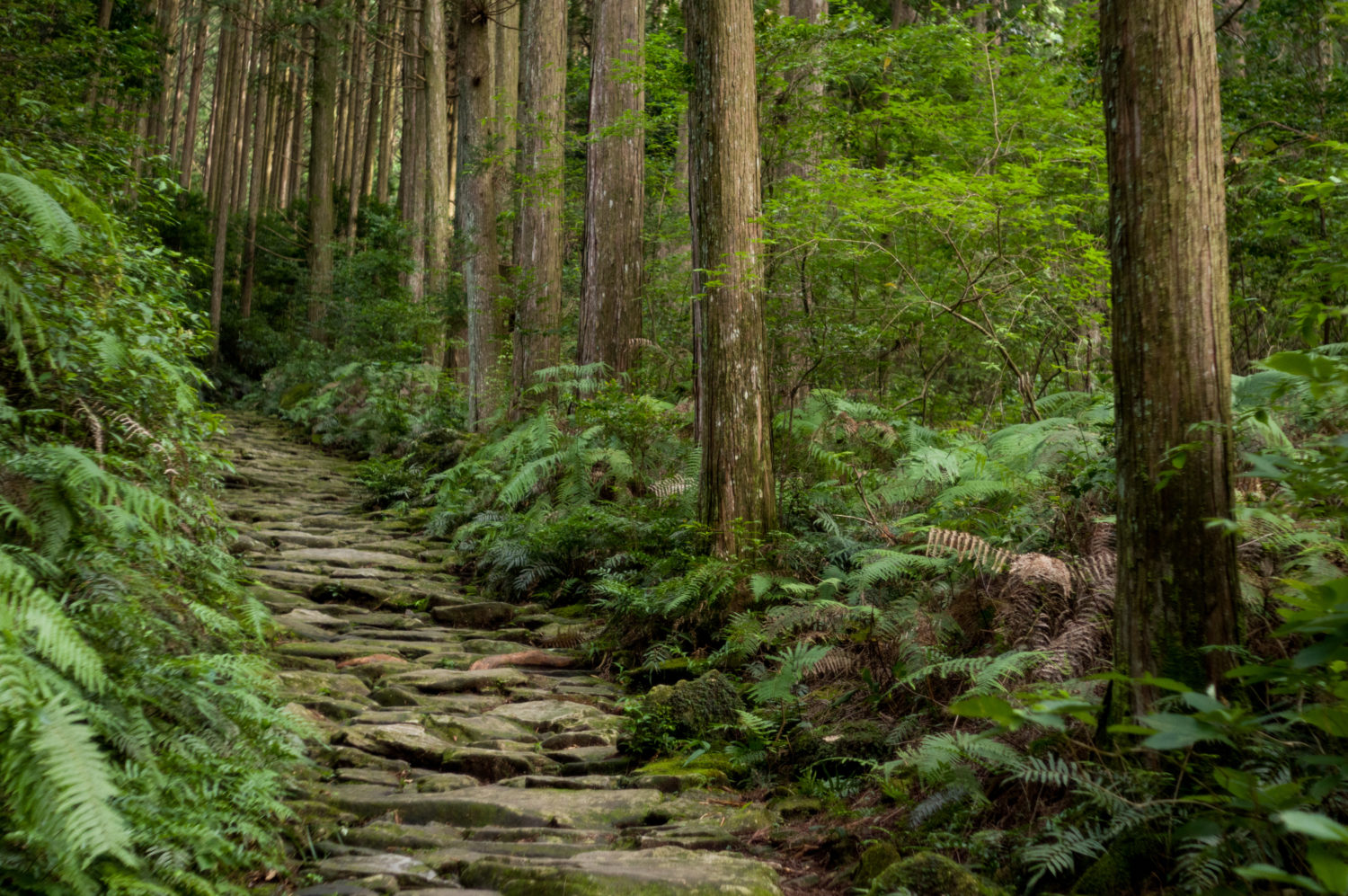
Sacred Journeys: The Kumano Kodo
Kumano Kodo Iseji
The Kumano Kodo Iseji Route features several remarkable mountain passes, with Matsumoto-toge and Magose-toge standing out as particularly impressive sections of this UNESCO World Heritage pilgrimage path.
Matsumoto-toge Pass provides a more accessible hiking experience, suitable even for novice mountaineers. At the summit, you’ll be greeted by a life-size guardian Jizo statue, creating a spiritual atmosphere amidst serene bamboo forests. Well-preserved stone pathways connect you directly to centuries of pilgrimage history.
Walking route of Magose-toge Pass stretches approximately 5.2 kilometres from Michi-no-eki Miyama and is celebrated for its exceptional preservation. About 2 kilometres of the original stone pathways remain intact, making it one of the most popular segments. From this pass, you can enjoy breathtaking panoramic views over the surrounding mountains and the stunning Sea of Kumano dotted with picturesque islands.
Both passes serve as physical and spiritual connections between Ise Grand Shrine and the Kumano Sanzan (Three Grand Shrines of Kumano), embodying the deep spiritual significance of this ancient route.
Hananoiwaya Shrine
Located in Kumano city, Hananoiwaya Shrine stands as one of Japan’s oldest Shinto shrines. Dedicated to the goddess Izanami no Mikoto, a co-creator of Japan according to mythology, the shrine’s focal point is a towering 45-metre rock formation known as “Hana no Iwaya” (Flower Rock), believed to serve as both her tomb and sacred space.
The shrine’s name derives from an ancient tradition where worshippers would carry seasonal flowers during pilgrimages to this holy site. Adjacent to Japan’s longest gravel beach, the shrine grounds offer a peaceful enclosure at the base of the rock where you can contemplate its spiritual significance.
Two significant festivals occur annually: on 2nd February, prayers for good harvests, and on 2nd October, thanksgiving celebrations. The site carries profound historical significance, being mentioned in the Nihon Shoki, Japan’s oldest history book.
As you approach the enclosed sacred area facing the Pacific Ocean, you’ll likely experience a palpable sense of reverence, embodying the enduring connection between Japanese religious traditions and natural landmarks.
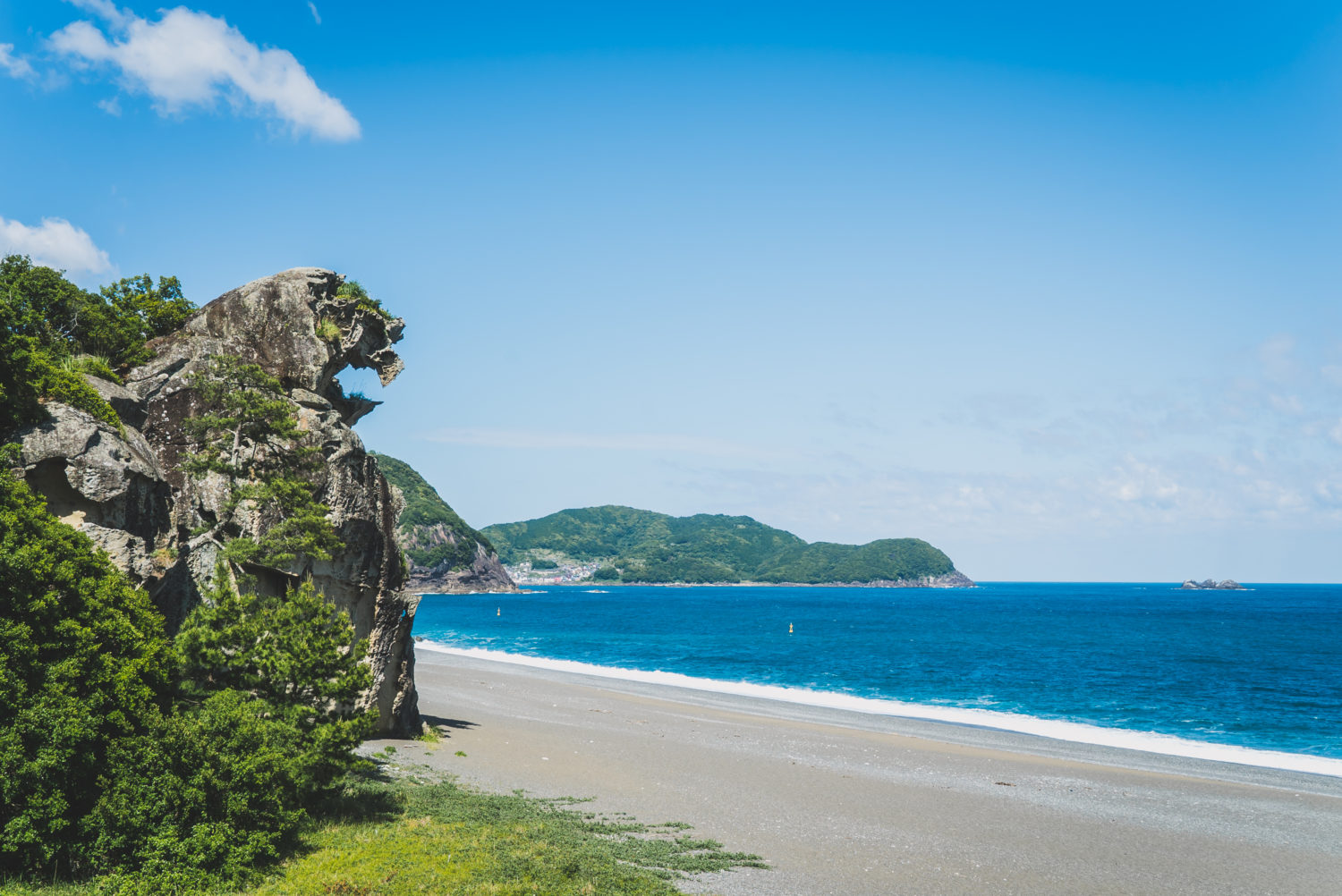
Coastal Wonders of Mie
Onigajo (Devil’s Castle)
Onigajo, meaning “Devil’s Castle” or “Ogre’s Castle”, is a remarkable natural formation located in Kumano. These striking coastal rock formations have been designated as part of the Yoshino-Kumano National Park and recognised as one of Japan’s 100 most scenic spots.
The dramatic landscape originated over 14 million years ago as a rugged coastal terrain in the Pacific Ocean. Through multiple geological uplifts over millennia, these rocks have been sculpted by natural forces into their current imposing form.
Local legends tell fascinating stories about these ancient rocks. Initially known simply as “Ogre’s Place”, the site was reportedly a hideout for pirates who terrorised passing ships. The name evolved to “Onigajo” after a ruler constructed a castle amongst these formidable rocks.
You can explore this 1.2 km stretch of craggy formations via walking paths that wind through them, offering spectacular views of the Pacific Ocean. The contrast between the dark, weathered rock and the blue sea is particularly compelling, especially during sunrise and sunset. The area has been recognised as both a World Heritage site and a national natural monument.
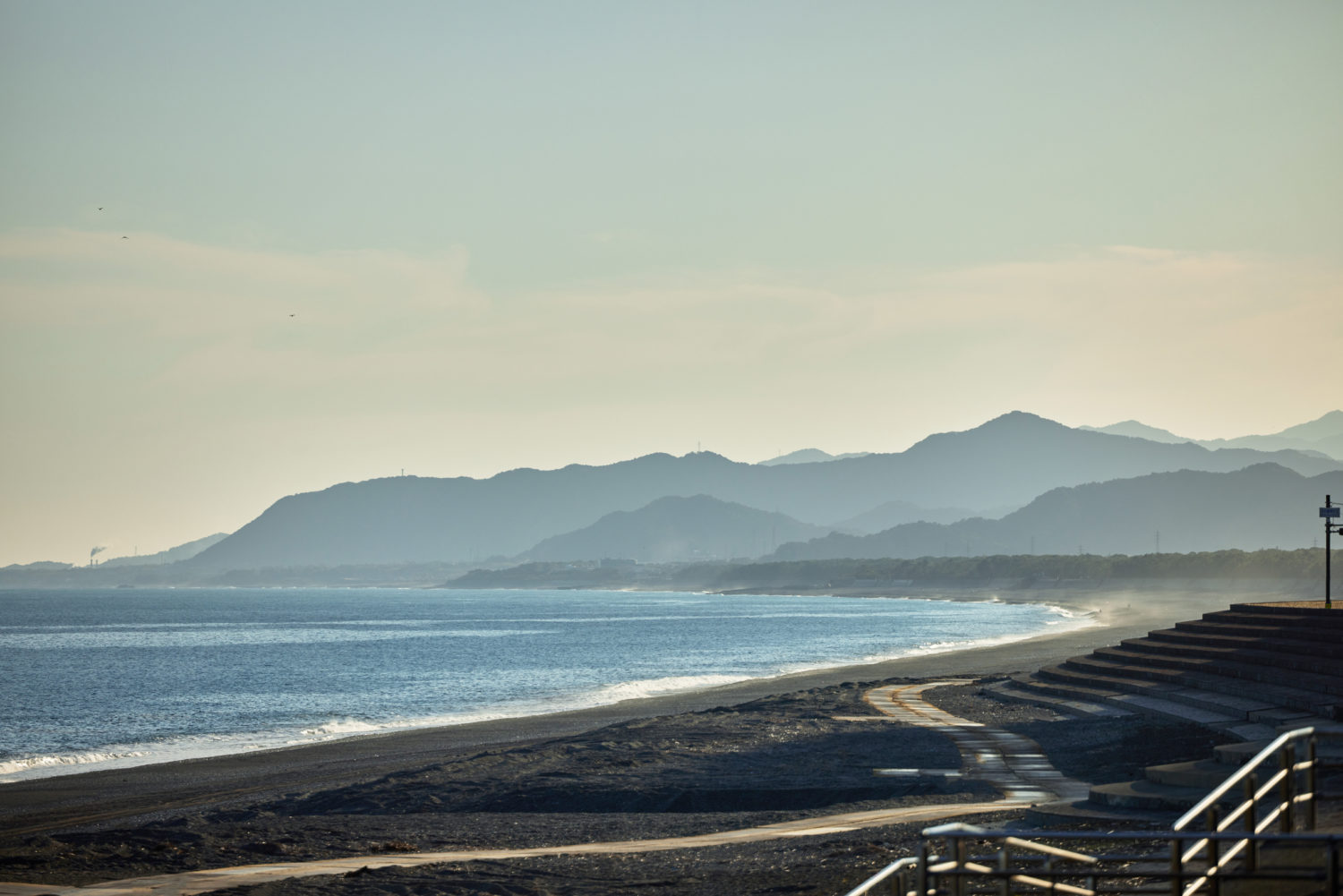
Shichirimihama
Stretching approximately 22 kilometres from Kumano City to Kiho Town, Shichirimihama stands as Japan’s longest gravel beach. This remarkable coastline features colourful boulders and varying textures, with some areas of sand interspersed among small stones.
The beach forms part of the UNESCO World Heritage-designated Kumano Kodo pilgrimage routes, specifically the section known as Hamakaido. Historically, local inhabitants have revered this coast as a spiritual site.
You can enjoy breathtaking scenery that transforms throughout the day—spectacular sunrises at dawn and vibrant sunset-painted waves in the evening. Seasonal highlights include hundreds of carp streamers flying above the shoreline in May, a grand fireworks festival in August, and traditional shrine festivals in October and February.
Located within Yoshino-Kumano National Park, Shichirimihama’s ever-changing landscape provides an extraordinary backdrop for walking and photography, with sweeping ocean views.
Just a 10-minute drive along the coast stands Shishi-iwa (Lion’s Head Rock), an unusual formation with a 210-metre circumference and 25-metre height. Recognised as both a national scenic beauty and natural monument, it pairs with a human-faced stone called “Shinsen-do,” traditionally serving as guardian figures for nearby Ohmajinja Shrine.
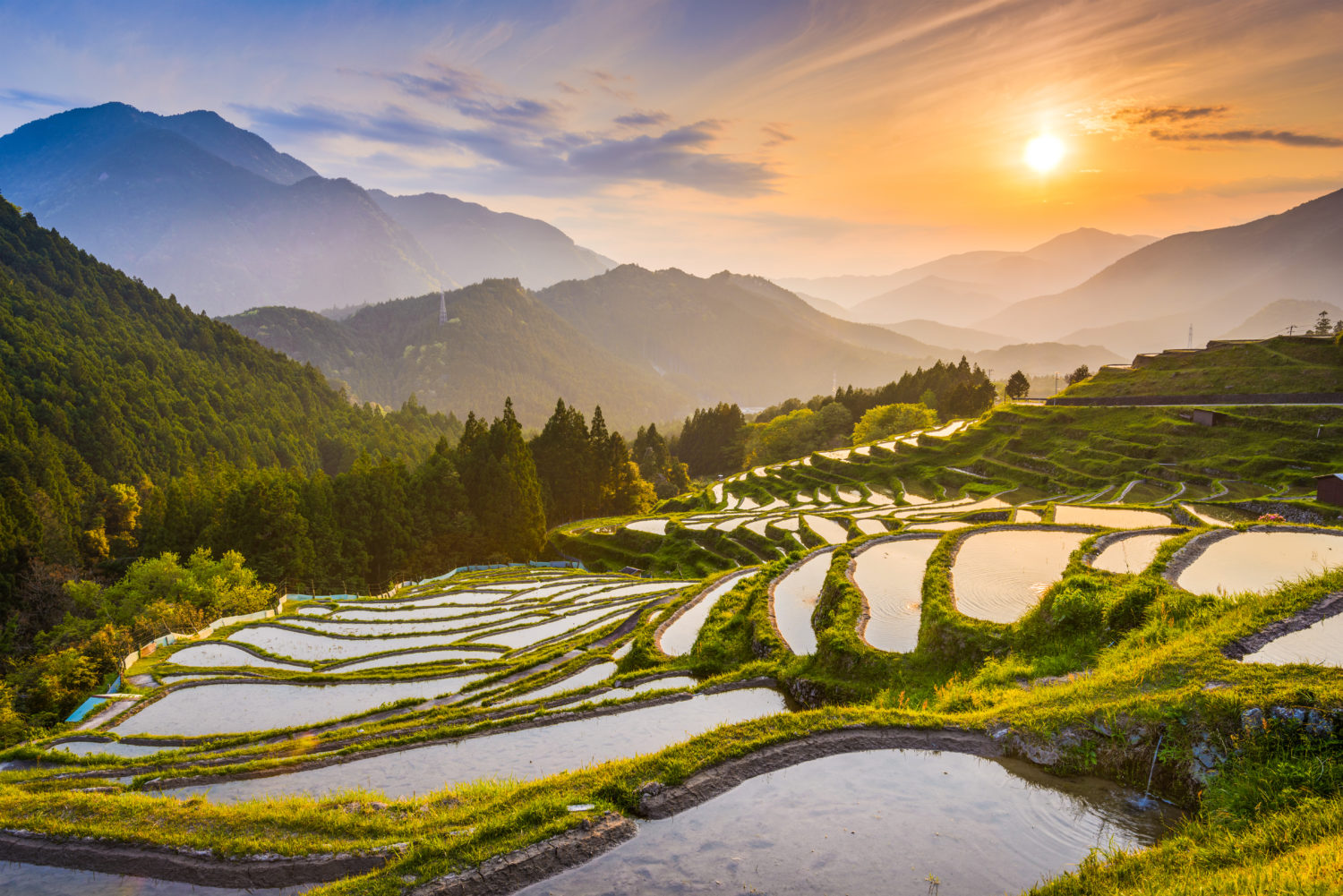
Traditional Crafts & Cultural Experiences
NUSHIKUMA (Owase Wappa)
Owase Wappa represents one of Mie’s most distinguished traditional handicrafts. These elegant bentwood containers are crafted from superior cypress wood grown in the Owase region, meticulously shaped into circular lunch boxes and food containers. NUSHIKUMA, established in 1887, is the sole producer of authentic Owase Wappa. This family-owned workshop has preserved traditional techniques for four generations, with both third-generation owner Mr Shoji and fourth-generation owner Mr Koshi Seko recognised as “intangible cultural assets” of Owase City.
The creation process involves approximately 45 stages spanning two months, from selecting premium cypress to applying multiple layers of urushi. The containers have natural antibacterial properties that help maintain food freshness. Originally developed for miners and fishermen during the Edo period, each piece showcases the stunning wood grain of Owase cypress beneath its glossy urushi coating.
ICHIGI MOMEN
Ichigi Momen is a traditional cotton textile from Mie with deep historical roots. This distinctive fabric has been produced in the Ichigi area for over a century, becoming an important cultural heritage of Higashikishu.
The production process relies on vintage power looms, some dating back nearly 100 years, which create textiles with a distinct texture and durability that modern machines cannot replicate.
Experience the world of Ichigi Momen through the “World Ichigi Discovery Tour”. Craftspeople demonstrate the weaving process and explain the distinctive characteristics that make this cotton special. The tour includes a quiz-based walking rally around historical sites, viewing rare Ichigi Momen items in a special exhibition, and a hands-on experience creating scented pouches.
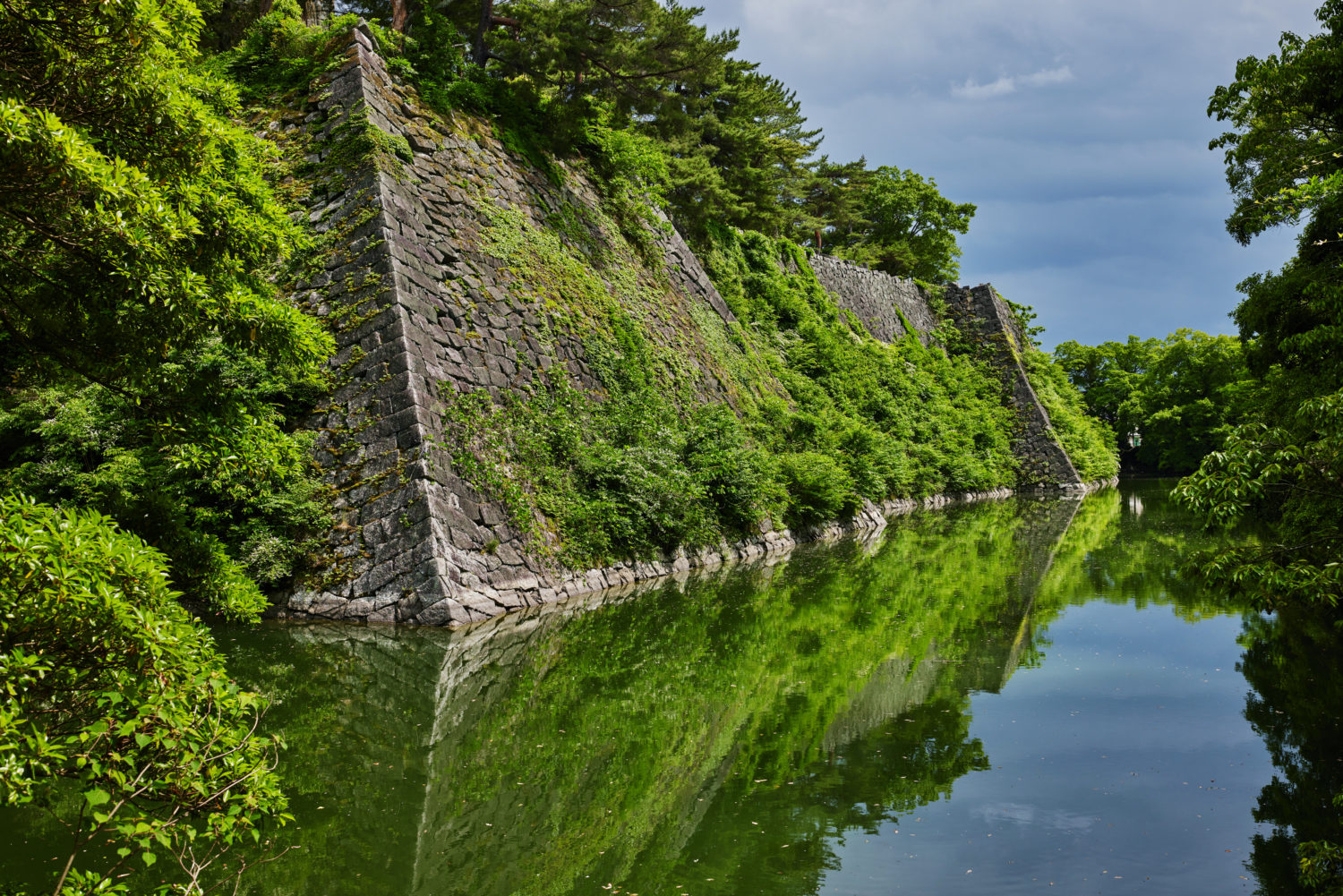
Natural Beauty & Outdoor Experiences
Kumano River Experience
The Kumano River offers a remarkable journey through Japan’s revered natural landscapes. This unique waterway holds the distinction of being the world’s only “river pilgrimage route” and is recognised within UNESCO’s World Heritage Sites.
From March to mid-December, experience the traditional “Sandanbo” boat tour—a leisurely cruise aboard distinctive wooden vessels with three sails that harness the wind, connecting you with the surrounding environment.
The two-hour tour operates from the Kumano River Experience office in Kiho, Mie, costing ¥5,000 for adults and ¥4,000 for children. Enjoy stunning views of natural wonders including the impressive Tsurigane-ishi Rocks and the magnificent Hisetsu Falls with its 30-metre drop, all whilst floating on emerald-green waters reaching depths over 20 metres.
For centuries, the river served as the primary route for pilgrims visiting the Kumano Sanzan shrines, with local boatmen maintaining this tradition for generations.
Maruyama Senmaida
Maruyama Senmaida stands as one of Japan’s most spectacular rice terraces. The name “Senmaida” literally translates to “thousand rice fields,” though the actual count reaches 1,340 paddies cascading down the steep slopes of Mount Shirakura.
Dating back to the 1600s, these terraces represent remarkable engineering and agricultural prowess, with stone retaining walls supporting each small field.
The visual impact changes dramatically with the seasons: in spring, newly filled paddies reflect the sky like mirrors; during summer, lush green rice plants sway in the breeze; autumn brings golden-yellow mature rice; and in winter, snow occasionally dusts the terraces. You’ll find dawn and dusk particularly magical, when soft light bathes the landscape. During winter evenings, special illuminations transform the terraces into a mystical scene, sometimes accompanied by a sea of clouds below.
Each paddy remains too small for modern machinery, requiring most farming to be done by hand. The terraces continue to exist thanks to government protection, dedicated locals, and an innovative ownership programme allowing people to sponsor individual paddies—ensuring they remain both a working agricultural site and a cherished cultural landscape.
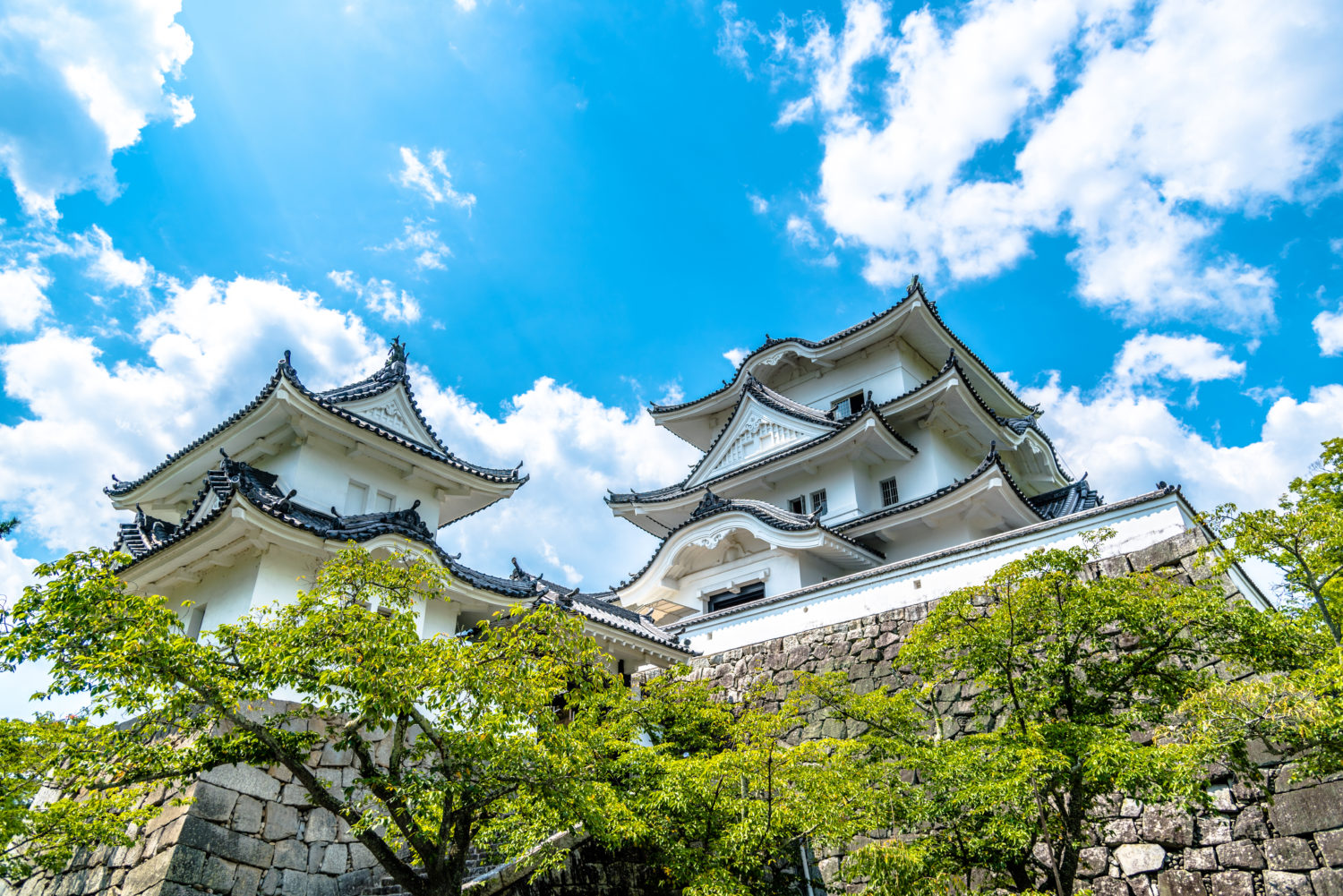
Relaxation and Accommodation
Resort KUMANO Club
Resort KUMANO Club stands as a premier luxury accommodation in southern Mi. This distinguished establishment offers you a perfect blend of traditional Japanese hospitality and modern comfort, creating an authentic ryokan experience with meticulous attention to detail that honours local customs whilst ensuring contemporary conveniences.
The property features Japanese/Western-style rooms, each equipped with large private baths and air conditioning. You’ll particularly appreciate the indoor and outdoor hot-spring baths (onsen), which provide a rejuvenating experience after a day of exploration.
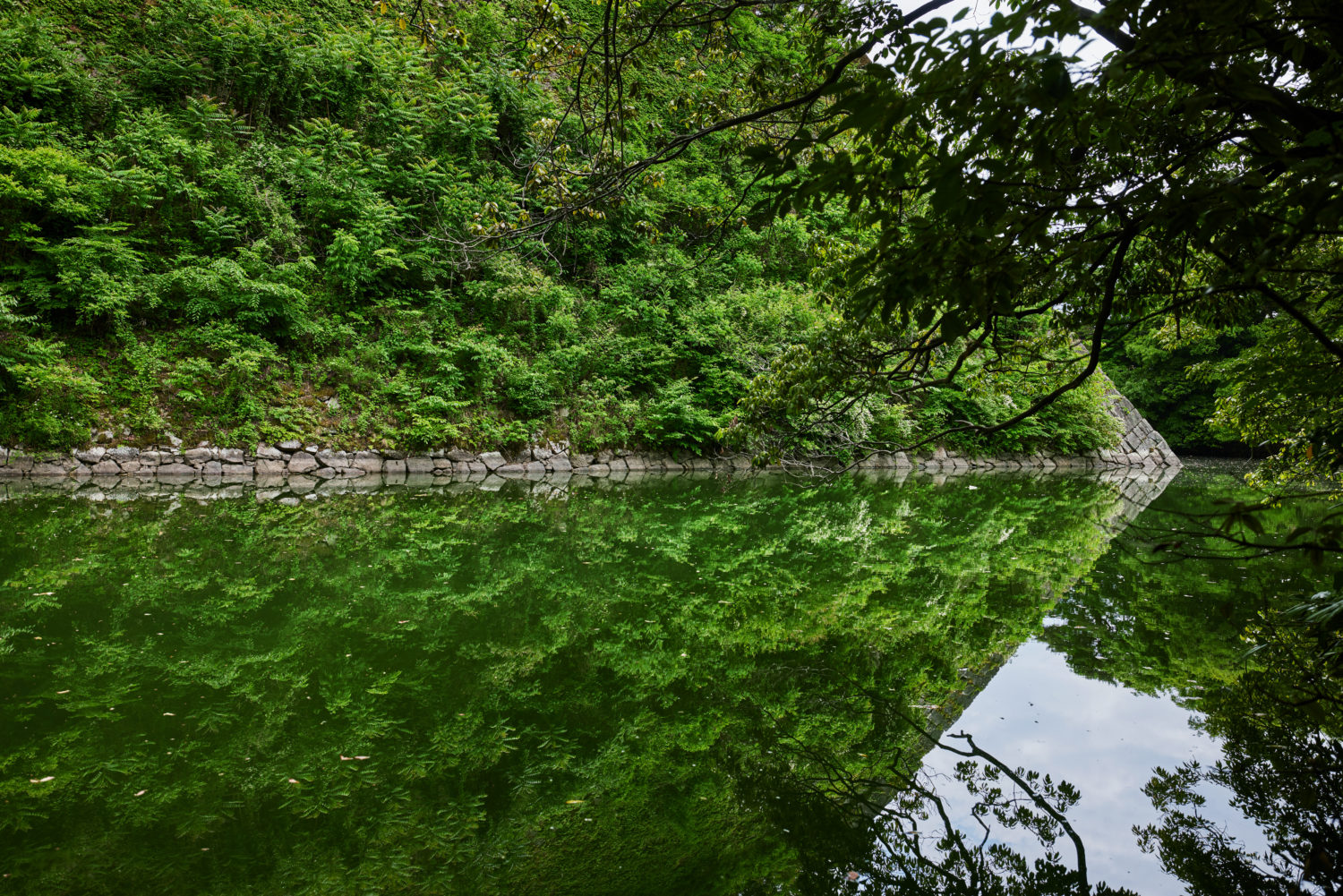
Dining at Resort KUMANO Club showcases Japanese cuisine, with traditional breakfast and dinner options highlighting local products from the Kumano region. The culinary offerings serve as an excellent introduction to the area’s gastronomic heritage , with seasonal specialities crafted by skilled chefs using time-honoured techniques.
The resort’s amenities include 24-hour front desk service, room service, and a gift shop. Its traditional Japanese garden creates a tranquil atmosphere that complements the surrounding natural beauty.
Located in the heart of the Kumano region, the resort serves as an ideal base for exploring southern Mie’s attractions, including the UNESCO World Heritage Kumano Kodo pilgrimage routes. From this comfortable base, you can easily access nearby natural landmarks, shrines, and cultural sites.







